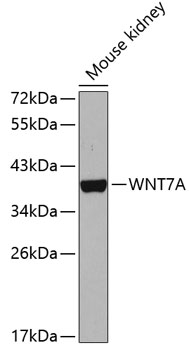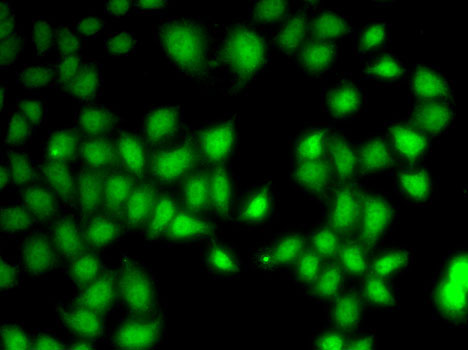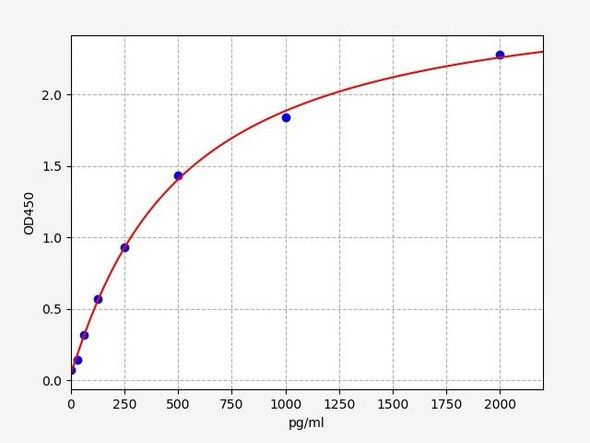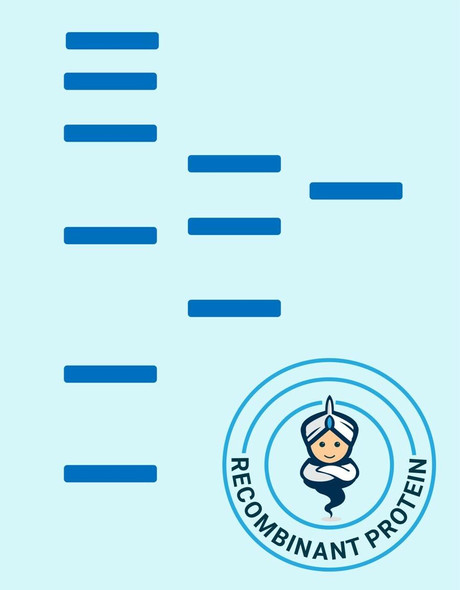Metabolism Antibodies 2
Anti-WNT7A Antibody (CAB5425)
- SKU:
- CAB5425
- Product Type:
- Antibody
- Reactivity:
- Human
- Reactivity:
- Mouse
- Host Species:
- Rabbit
- Isotype:
- IgG
- Antibody Type:
- Polyclonal Antibody
- Research Area:
- Metabolism
Description
| Antibody Name: | Anti-WNT7A Antibody |
| Antibody SKU: | CAB5425 |
| Antibody Size: | 20uL, 50uL, 100uL |
| Application: | WB IF |
| Reactivity: | Human, Mouse |
| Host Species: | Rabbit |
| Immunogen: | Recombinant fusion protein containing a sequence corresponding to amino acids 32-170 of human WNT7A (NP_004616.2). |
| Application: | WB IF |
| Recommended Dilution: | WB 1:500 - 1:2000 IF 1:10 - 1:100 |
| Reactivity: | Human, Mouse |
| Positive Samples: | Mouse kidney |
| Immunogen: | Recombinant fusion protein containing a sequence corresponding to amino acids 32-170 of human WNT7A (NP_004616.2). |
| Purification Method: | Affinity purification |
| Storage Buffer: | Store at -20'C. Avoid freeze / thaw cycles. Buffer: PBS with 0.02% sodium azide, 50% glycerol, pH7.3. |
| Isotype: | IgG |
| Sequence: | LGAS IICN KIPG LAPR QRAI CQSR PDAI IVIG EGSQ MGLD ECQF QFRN GRWN CSAL GERT VFGK ELKV GSRE AAFT YAII AAGV AHAI TAAC TQGN LSDC GCDK EKQG QYHR DEGW KWGG CSAD IRYG IGFA KVFV DAR |
| Gene ID: | 7476 |
| Uniprot: | O00755 |
| Cellular Location: | Secreted, extracellular matrix, extracellular space |
| Calculated MW: | 39kDa |
| Observed MW: | 39kDa |
| Synonyms: | WNT7A |
| Background: | This gene is a member of the WNT gene family, which consists of structurally related genes that encode secreted signaling proteins. These proteins have been implicated in oncogenesis and in several developmental processes, including regulation of cell fate and patterning during embryogenesis. This gene is involved in the development of the anterior-posterior axis in the female reproductive tract, and also plays a critical role in uterine smooth muscle pattering and maintenance of adult uterine function. Mutations in this gene are associated with Fuhrmann and Al-Awadi/Raas-Rothschild/Schinzel phocomelia syndromes. |
| UniProt Protein Function: | WNT7A: Ligand for members of the frizzled family of seven transmembrane receptors. Probable developmental protein. Signaling by Wnt-7a allows sexually dimorphic development of the mullerian ducts. Defects in WNT7A are the cause of limb pelvis hypoplasia aplasia syndrome (LPHAS). A syndrome of severe deficiency of the extremities due to hypo- or aplasia of one or more long bones of one or more limbs. Pelvic manifestations include hip dislocation, hypoplastic iliac bone and aplastic pubic bones. Thoracic deformity, unusual facies and genitourinary anomalies can be present. Defects in WNT7A are a cause of Fuhrmann syndrome (FUHRS); also known as fibular aplasia or hypoplasia femoral bowing and poly- syn- and oligodactyly. Fuhrmann syndrome is a distinct limb-malformation disorder characterized also by various degrees of limb aplasia/hypoplasia and joint dysplasia. Belongs to the Wnt family. |
| UniProt Protein Details: | Protein type:Secreted; Secreted, signal peptide Chromosomal Location of Human Ortholog: 3p25 Cellular Component: proteinaceous extracellular matrix; extracellular space; cell surface; endoplasmic reticulum lumen; Golgi lumen; plasma membrane; extracellular region Molecular Function:frizzled binding; cytokine activity; receptor agonist activity; receptor binding Biological Process: embryonic forelimb morphogenesis; somatic stem cell maintenance; positive regulation of epithelial cell proliferation involved in wound healing; cell proliferation in forebrain; neurotransmitter secretion; positive regulation of transcription, DNA-dependent; positive regulation of JNK cascade; Wnt receptor signaling pathway through beta-catenin; palate development; embryonic hindlimb morphogenesis; response to estradiol stimulus; negative regulation of neurogenesis; neuron differentiation; central nervous system vasculogenesis; regulation of axon diameter; synapse organization and biogenesis; somatic stem cell division; chondrocyte differentiation; satellite cell activation; angiogenesis; fallopian tube development; cartilage condensation; cell fate commitment; embryonic axis specification; satellite cell compartment self-renewal involved in skeletal muscle regeneration; cerebellar granule cell differentiation; asymmetric protein localization; positive regulation of synaptogenesis; stem cell development; dorsal/ventral pattern formation; establishment of cell polarity; positive regulation of transcription from RNA polymerase II promoter; embryonic digit morphogenesis; sex differentiation; negative regulation of apoptosis Disease: Ulna And Fibula, Absence Of, With Severe Limb Deficiency; Fibular Aplasia Or Hypoplasia, Femoral Bowing And Poly-, Syn-, And Oligodactyly |
| NCBI Summary: | This gene is a member of the WNT gene family, which consists of structurally related genes that encode secreted signaling proteins. These proteins have been implicated in oncogenesis and in several developmental processes, including regulation of cell fate and patterning during embryogenesis. This gene is involved in the development of the anterior-posterior axis in the female reproductive tract, and also plays a critical role in uterine smooth muscle pattering and maintenance of adult uterine function. Mutations in this gene are associated with Fuhrmann and Al-Awadi/Raas-Rothschild/Schinzel phocomelia syndromes. [provided by RefSeq, Jul 2008] |
| UniProt Code: | O00755 |
| NCBI GenInfo Identifier: | 145559540 |
| NCBI Gene ID: | 7476 |
| NCBI Accession: | O00755.2 |
| UniProt Secondary Accession: | O00755,Q96H90, Q9Y560, |
| UniProt Related Accession: | O00755 |
| Molecular Weight: | 349 |
| NCBI Full Name: | Protein Wnt-7a |
| NCBI Synonym Full Names: | wingless-type MMTV integration site family, member 7A |
| NCBI Official Symbol: | WNT7A |
| NCBI Protein Information: | protein Wnt-7a; proto-oncogene Wnt7a protein |
| UniProt Protein Name: | Protein Wnt-7a |
| UniProt Gene Name: | WNT7A |
| UniProt Entry Name: | WNT7A_HUMAN |








